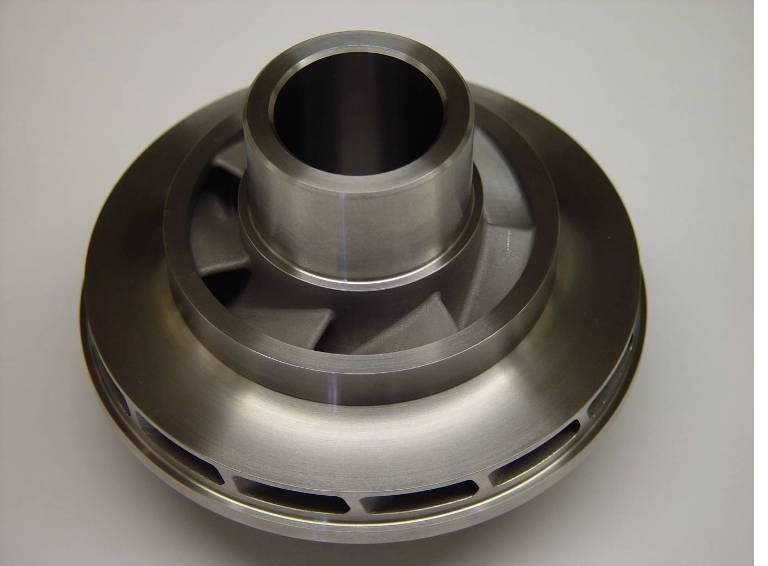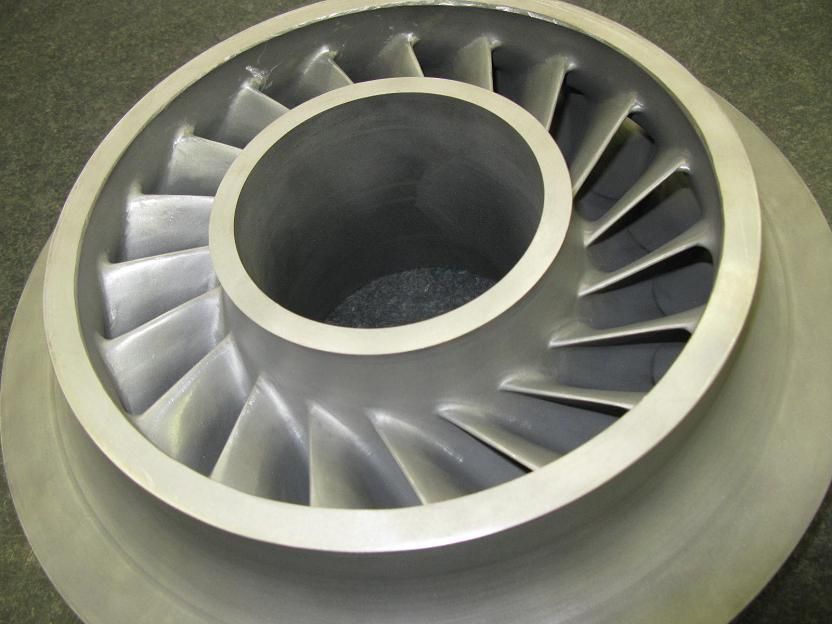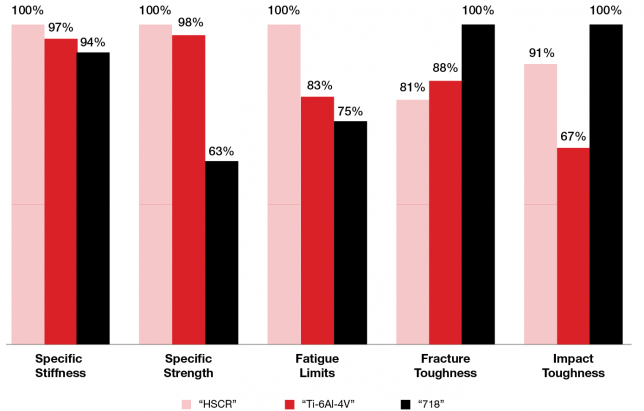High-strength, corrosion-resistant steel can be an effective alloy alternative
Highly stressed turbomachinery components, including impellers, shafts, housing, and bolts are subjected to severe loading, oxidation, corrosion, and in some cases hydrogen embrittlement. High-strength titanium alloys and high-strength, nickel-based alloys are widely used for those components. The main criteria for choosing materials are strength, specific strength (tensile strength to density ratio), fatigue strength, toughness, and corrosion/oxidation resistance. Titanium alloy Ti-6Al-4V, and the nickel-based alloy 718 and alloy 625 fit these criteria. Cost and machining issues limit application.
High-strength, corrosion-resistant (HSCR) steel is a possible low-cost alternative. Premium-quality HSCR steel ingots are produced by vacuum melting processes. A powdered form of HSCR steel is produced by atomization processes, including vacuum atomization.
Components can be manufactured from HSCR steel by four processes:
- Hot working (HW) of ingots by forging or rolling followed by machining and hardening.
- Powder metallurgical-based, hot isostatic pressing (PM HIP) to near net shapes (NNS) followed by finish machining, and hardening (NNS PM HIP).
- Additive manufacturing (AM) followed by surface finishing and heat treatment.
- Vacuum casting followed by hot isostatic pressing, finish machining, and hardening (Casting + HIP).
Hardening of HSCR steel consists of austenitizing and rapid cooling, optional refrigerating, and tempering at low, medium, and high temperatures (secondary hardening) depending on the required properties. Formation of NNS by PM HIP enables manufacturing of various complex-shaped components. The process provides precise geometry and properties close to the forgings. Also, PM HIP supplies a homogeneous microstructure through any cross section.
The cost of components made by PM HIP is generally higher than the same products made by HW. However, small batches of complex products produced by PM HIP are economically feasible compared to HW (Figures 1A & B).

Figure 1A: Impeller made by PM HIP from Ti-6Al-4V alloy powder (A) (Source: LNT PM).[/caption]

Figure 1B: Gas compressor impeller made by PM HIP from Inconel alloy 625M powder.
(Source: LNT PM).[/caption]
NNS components made by PM HIP are cost effective due to waste minimization and their buy-to-fly ratio (mass of raw material to mass of product) being lower than HW components.
The high cost of titanium alloy and nickel-based alloy powders, as well as issues with machining, limit their application. Critical components made by PM HIP from HSCR steel powder are a good alternative to those made from titanium nickel-based alloys due to lower cost and better machinability for the same lifetime and durability.

Table 1: Mechanical properties of HSCR steel, Ti-6Al-4V alloy, and Inconel alloy 718 made by four different processes.[/caption]
Comparing processes
The components made by AM have a buy-to-fly ratio lower than the components produced by PM HIP. However, the high cost of powder for AM, high-energy consumption, and issues with surface finishing limit application of AM processes.
Casting + HIP has the lowest cost among processes. But it supplies lower strength compared to HW, PM HIP and AM. A combination of casting + HIP is feasible for manufacturing of components from HSCR steel. The projected cost reduction of critical components is 65% (more when compared to the same weight of components made by AM from Ti-6Al-4V alloy and alloy 718 powders).
The various processes used produce different mechanical properties (Figure 2). A variety of techniques are employed, depending on the material. HW + hardening of forged HSCR steel, for example, is accomplished by quenching, refrigerating, tempering, and finally air cooling. Forged Ti-6Al-4V alloy and Inconel alloy 718 are hardened by heat treatment.

Figure 2: The room-temperature mechanical properties of HSCR steel, Ti-6Al-4V alloy and Inconel alloy 718.[/caption]
Figure 2 shows a comparison of the mechanical properties of vacuum melted, forged, and hardened HSCR steel, Ti-6Al-4V alloy, and Inconel alloy 718. HSCR steel possesses higher specific stiffness (E/ρ) and specific strength (UTS/ρ), higher fatigue limits (S), lower fracture toughness (K1c) and higher impact toughness (CVN) compared to Ti-6Al-4V alloy. Additionally, HSCR steel has a higher elevated temperature strength up to 950°F compared to Inconel alloy 718 and a higher elevated temperature strength up to 1200°F compared to Ti-6Al-4V alloy.
HSCR steel also has greater workability and machinability, and better wear resistance. Alloy 718 and Ti-6Al-4V alloy have better corrosion and oxidation resistance compared to HSCR steel; but HSCR steel has no rust after a salt spray test (ASTM B117 using a 5% NaCl concentration, natural pH, at 95°F, for 200 hours).
Given its mechanical properties, critical components made by HW, PM HIP, and AM processes from Ti-6Al-4V alloy and alloy 718 can be replaced by HSCR steel without sacrificing stiffness, durability or lifetime (Table 1).

Table 2: Qualitative rating for HEE of materials tested at 75°F under hydrogen pressure of 9.8 ksi. Those deemed negligible or small risk can be utilized in the specified hydrogen pressure & temperature range. Those graded high can be cautiously utilized only for limited applications; the extreme and severe classes are not recommended.[/caption]
In terms of cost, HSCR steel is an attractive alternative (Figure 3). There is a significant reduction in cost for components made by HW, PM HIP, and AM using HSCR steel. At the same time, utilization of HSCR steel reduces dependency on Ti, Ni, Mo, and Nb. Efforts by Siemens Energy, GE Gas Power, Mitsubishi Power, Ansaldo Energia, and others to develop hydrogen-fueled turbines have shifted into high gear.
Hydrogen embrittlement of critical components is a major challenge. The hydrogen environment embrittlement (HEE) rating of materials varies widely (Table 2). Ti-6Al-4V, Inconel alloy 718, Inconel alloy 625 and HSCR steel should not be utilized for hydrogen-fueled gas turbine components.
High-strength aluminum alloys 2000 and 7000 series are a better choice; however, their strength up to 70 ksi at 75°F and up to 30 ksi at 400°F limits application. Similarly, Type 316 austenitic stainless steel has a negligible HEE rating, but possesses strength of only 90 ksi at 75°F and 80 ksi at 400°F. That is not enough for the highly stressed components.
A protective coating or plating is required. For prevention of HEE in high strength steels, the most attractive are Zn-Ni and Zn-Ni-Me coatings (thermostability up to 500°F). Components made from HSCR steel and protected by such coatings can be utilized with hydrogen-fueled gas turbines. A more robust approach consists of plating or cladding of HSCR steel components with 316 stainless steel.
Los Angeles-based LNT PM and Synertech PM have developed NNS PM HIP technology for critical gas turbine components. This includes hydrogen-fueled parts made by PM HIP from HSCR steel powder. Pilot production of these parts is underway. ■
Dr. Gregory Vartanov is chief engineer at Advanced Materials Development Corp., a Toronto-based company that develops high-strength steels and alloys. He holds an M.S. and Ph.D. in materials science and metallurgy. For more information and more details on these materials, please contact info@amdoncorp.com or visit amdoncorp.com
